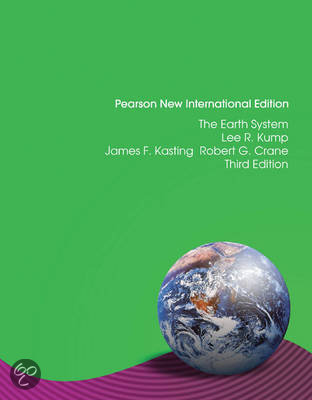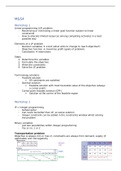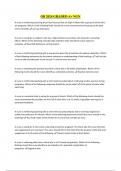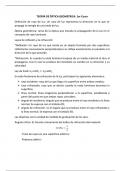Chapter 2 Daisyworld .................................................................................................................................... 3
The DAISYWORLD Climate System ............................................................................................................ 3
Chapter 5 The Circulation of the Oceans ....................................................................................................... 5
Subsurface flow ......................................................................................................................................... 5
Boundary Currents: asymmetry................................................................................................................. 6
The circulation of the deep ocean ............................................................................................................. 7
Linking the Thermohaline Circulation and the Wind Driven Surface Flow ............................................... 8
Ocean Circulation and Climate .................................................................................................................. 8
Summary .................................................................................................................................................... 8
Chapter 6 The Cryosphere ............................................................................................................................. 9
River and lake ice, seasonal snow cover and permafrost ......................................................................... 9
Glaciers and icesheets ............................................................................................................................... 9
Sea ice and climate .................................................................................................................................. 10
Not in the book ........................................................................................................................................ 11
Chapter 7 Circulation of the Solid Earth; Plate Tectonics............................................................................ 13
Anatomy of Earth ..................................................................................................................................... 13
Plate tectonics ......................................................................................................................................... 14
Plate and plate boundaries ...................................................................................................................... 15
What drives plate tectonics? ................................................................................................................... 16
The rock cycle .......................................................................................................................................... 16
Chapter 8 Recycling of the Elements ........................................................................................................... 18
Short-term organic carbon cycle ............................................................................................................. 19
Short-term Marine Organic Carbon cycle ................................................................................................ 19
Long-term Organic Carbon Cycle (1000-1,000,000 yr) ............................................................................ 19
The inorganic carbon cycle ...................................................................................................................... 20
Carbonate cycle ................................................................................................................................... 20
Silicate cycle ......................................................................................................................................... 20
Chapter 9 Focus on the biota ...................................................................................................................... 21
Systems with positive feedbacks, to maintain themselves ..................................................................... 22
Boreal forest and permafrost .............................................................................................................. 22
Amazone .............................................................................................................................................. 23
Chapter 10 Origin of Earth and of Life ......................................................................................................... 24
1
, Formation of the solar system (Earth and the moon) ............................................................................. 24
Formation of the atmosphere and ocean................................................................................................ 25
The origin of life ....................................................................................................................................... 25
Chapter 11 Effect of Life on the Atmosphere; the rise of oxygen and ozone ............................................. 27
Effect of life on the early atmosphere ..................................................................................................... 27
The rise of oxygen .................................................................................................................................... 27
Variations in O2 in the last 2 billion years ................................................................................................ 28
Modern controls on oxygen .................................................................................................................... 28
Chapter 12 Long-Term Climate Regulation ................................................................................................. 30
An CO2 rich early atmosphere?................................................................................................................ 30
Effect of Methane one Archean Climate ................................................................................................. 31
The Long-term Climate Record ................................................................................................................ 32
Chapter 13 Biodiversity through Earth History ........................................................................................... 35
Chapter 14 Pleistocene Glaciations ............................................................................................................. 37
Evidence of Pleistocene glaciation .......................................................................................................... 37
Glacial climate feedbacks ........................................................................................................................ 37
The Younger Dryas ................................................................................................................................... 40
Chapter 15 Short term climate variability ................................................................................................... 42
Holocene climate change ........................................................................................................................ 42
Modelling the Earth system ..................................................................................................................... 43
El Niño-Southern Oscillation (ENSO) Events ............................................................................................ 43
Future Climate ......................................................................................................................................... 43
Chapter 17 Atmospheric Chemistry ............................................................................................................ 45
Stratospheric Ozone ................................................................................................................................ 45
Aerosols in the troposphere .................................................................................................................... 46
Oxidation.................................................................................................................................................. 46
Future Climate ......................................................................................................................................... 46
Effects on surface temperatures (H5) ..................................................................................................... 47
2
,Chapter 2 Daisyworld
System: an entity composed of diverse but interrelated parts that function as a complex whole. We call
those parts components. The state of a system is the set of important attributes that characterize the
system a particular time. Those attributes being linked together makes it possible to maintain control of
important attributes. The links are called couplings. There are two kinds: positive coupling (----->, [a
change in one component stimulates a change in the other component in the same direction]) and
negative coupling ( ----o ). The sign of the coupling will match the sign of the slope if you make a graph. A
feedback loop is created by two or more couplings. Feedback is a self-perpetuating mechanism of
change and response to that change. In a negative feedback loop, the effects of disturbances are
diminished. In positive feedback loops the effects of disturbances are amplified. A simple way to identify
the sign of the loop is by counting the number of negative couplings; an odd number means a negative
feedback loop.
Equilibrium state: the state in which the system will remain, unless it is disturbed. A negative feedback
loop gives us a stable steady state. Modest disturbances will be followed by a return to the steady state.
A positive feedback loop gives us an unstable steady state. The system will be carried further and further
away. This applies only in theory!
Perturbations are temporary disturbances of the system, for example a volcanic eruption or fertilization
of the oceans by dust. A more persistent disturbance is called a forcing, like the gradual increase in
sunlight or Milankovich cycles.
Earth system:
Components: oceans, atmosphere, cryosphere, ….
State variables: Earth’s orbital rotation state, energy balance, temperature, composition, …
Component interactions: exchange of energy, H2O, matter, …
The DAISYWORLD Climate System
Daisyworld is the prove that natural systems can be self-regulation without the need for intelligent
intervention (Gaia hypothesis). Daisyworld is a planet partly covered in white daisies and further
covered with gray soil. Its sun is increasing in strength at a high rate. The daisies have a higher albedo
The more daisies, the more sunlight reflect off their white
petals, the less sunlight absorbed, and finally the cooler
the surface temperature.
(reflectivity).
This gives a negative linear graph. A graph of the growth rate depending on temperature can be drawn
as a parabola. If you place the two on each other you will get the equilibrium states. The sign of the
feedback loops depends on the temperature of the planet. There is a perturbation that will make T>Topt,
temperature will become too high and the daisies will die.
3
, Figure 1 At
any point on
the parabola
other than P1
or P2, the
effect T on
daisy cover is
correct, but
not the effect
of daisy cover
on T.
With a small permanent increase in sunlight, there will be a new
equilibrium at a higher temperature. We could view this an upward
shift of the straight line. This will give us the new equilibria;
Daisyworld has reacted to the increased solar luminosity by
increasing the daisy coverage. The accompanying increase in albedo
explains why the temperature did not rise as much as it would have
without feedback. So the consequence of the feedback is a longer
life span for the daisies than one would predict if there were no
feedback in the system.
∆𝑇𝑒𝑞 = ∆𝑇0 + ∆𝑇𝑓
We quantify the strengt of the feedback effect with the feedback
factor f. f is between 0 and 1 for a negative feedback loop, but f>1
for a postive feedback loop. For unstable systems Teq is not defined,
so we have no f.
𝑡𝑒𝑚𝑝𝑒𝑟𝑎𝑡𝑢𝑟𝑒 𝑐ℎ𝑎𝑛𝑔𝑒 𝑤𝑖𝑡ℎ 𝑓𝑒𝑒𝑑𝑏𝑎𝑐𝑘 ∆𝑇𝑒𝑞
𝑓= =
𝑡𝑒𝑚𝑝𝑒𝑟𝑎𝑡𝑢𝑟𝑒 𝑐ℎ𝑎𝑛𝑔𝑒 𝑤𝑖𝑡ℎ𝑜𝑢𝑡 𝑓𝑒𝑒𝑑𝑏𝑎𝑐𝑘 ∆𝑇0
Important is to realize that the daisies in Daisyworld do not optimize their environment (T).
Hysteresis is het
verschijnsel dat het
verband tussen oorzaak
en gevolg niet alleen
afhangt van de grootte
van de oorzaak, maar
ook van de richting
waarin de oorzaak
verandert
Figure 2 The results
4
, Chapter 5 The Circulation of the Oceans
Subsurface flow
Atmosferic Circulation Ocean Circulation
Heating at lower surface Heating at upper surface
Radiation penetrates through entire surface Heating of the top 100 m
Warm surface under cold surface Warm surface above cold surface
Density differences due to temperature Density differences due to temperature and
salinity
Low heat capacity, large ∆T High heat capacity, small ∆T
Surface heating generates density Does not circulate as a direct
differences which triggers circulation response to surface heating, but the water is
dragged along by the wind
Coriolis effect; deflecting NH winds to Coriolis effect; deflecting NH winds to
the right, SH to the left the right, SH to the left
No barrier against circulation imposed Continents impose a barrier on
by continents circulation
Differences with reality:
In reality there is a large eastward-
flowing current – the West Wind
Drift – around Antarctica because
of the absence of land.
Convergence: water is piling up in
#2 because of the Ekman spiral
(zie blz. 104) downwelling
Divergence: water streams away
from coasts (and the equator)
resulting in desert areas
upwelling
Figure 3 Simplified view of the surface-ocean
circulation as a result of atmospheric currents
Bovenstaande upwelling en downwelling leiden tot de Geostrophic Current:
een gevolg van de pressure-gradient force en de corioliskracht. Dat leidt tot
een stroming in dezelfde richting als die die veroorzaakt wordt door de wind
(figuur 3).
5












